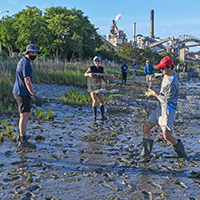Strengthening the Shoreline

Dr. Kelly Smith and more than a dozen students arrived at Amelia River in Fernandina Beach early on a Saturday morning. Working in boots in the water at low tide, they were hauling crab traps filled with oyster shells and placing them in just the right location to create a new and inviting home for area oysters. In essence, these volunteers were helping Mother Nature.
If all goes as planned, they expect the oysters to attach themselves to the submerged traps and fuse together to create an imitation of a natural oyster reef. Referred to as a living shoreline, this new habitat is expected to grow and strengthen over time to help stabilize the coastline and reduce erosion.
Smith, an associate professor of biology at UNF, was there to offer her expertise, something she’s happy to do as a community volunteer in order to assist area organizations working to improve coastal resilience. At this river location, she was advising the St. Mary’s Riverkeeper organization, which was coordinating the project. Smith’s students from UNF’s Coastal and Marine Biology program worked with other Riverkeeper volunteers to place about 50 crab traps and in return gained valuable field experience.
Locating the oyster homes is not only muddy, but can be somewhat complicated. “You’ve got to put the structures at the right elevation, otherwise they get flooded too much or they don’t get flooded, so working at low tide allowed us to pick the best location,” Smith said. “Then what happens is we kind of hope, ‘If we build it, they will come.’”
Oysters, it seems, like to attach to hard surfaces. If they decide to move in, the reef they build also will create habitats for fish to hide in and feed. In addition, oysters are able to remove algae from the water, helping to reduce algal blooms and produce cleaner water for wildlife, fishing and recreation.
With the new homes in place, some of the students will continue with the project as a research study. After Smith provides training in field monitoring techniques, the students will follow the progress of the living shoreline to answer a number of questions: How many baby oysters were able to attach and survive over time? Has the structure lessened erosion as compared with regions that were not restored? The research seeks information that will be vital in preserving reefs in the future.
In addition to the benefit students gain from helping with community projects, Smith believes the research study will combine important learning experiences with the exposure that will help them to land a job. During her 20-plus years of teaching at UNF, Smith said she has seen students struggle to find jobs.
“Grades are one thing, and that’s important, but a lot of organizations want to know that someone’s actually been tested in the field and can do the work,” Smith said. “One of my major goals for all my projects is providing on-the-ground training so the students can be job ready.”
UNF Journal: Fall 2021
- Doug Eng Captures Local Beauty
- Exploring Florida's Ecosystems
- Florida’s Water and Disease: What are the Risks?
- Harvesting Renewable Energy from the Ocean
- Strengthening the Shoreline
- Studying Wetlands with Local Scientist
- Szymanski Named CEO and Executive Director of UNF MedNexus
- UNF Athletics Bids Goodbye to Pivotal Leader; Welcomes New AD
- UNF Introduces the Crowley Center
- UNF’S Largest Competitive Grant to Fund Alzheimer's Research
